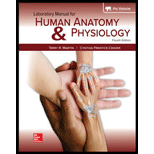
Concept explainers
The sense organs associated with equilibrium are within the
a. outer ear.
b. middle ear.
C. inner ear.
d. tympanic membrane.
Introduction :
With the help of two sets of sensory organs, equilibrium is maintained in the body. One set of sense organs makes the head and body stable and makes a sense of gravitational equilibrium. The second set of organs balances the head and body and makes the sense of rotational equilibrium.
Answer to Problem 1PL
Correct answer :
Option (c), inner ear.
Explanation of Solution
Explanation/justification for the correct answer :
Option (c) is inner ear. The inner ear contains the sense organs that senses hearing and maintains equilibrium. Hence, this option is correct.
Explanation for incorrect answer :
Option (a) is outer ear. The function of the outer ear is to collect the sound waves and direct them to the tympanic membrane. Hence, this option is incorrect.
Option (b) is middle ear. Its function is to transfer acoustic energy from compression waves to fluid membrane waves present in the cochlea. Hence, this option is incorrect.
Option (d) is tympanic membrane. Tympanic membrane is the eardrum that receives sound vibrations and then transmit them to the auditory ossicle. It is the part of the outer ear. Hence, this option is incorrect.
Option (c), inner ear.
Want to see more full solutions like this?
Chapter 38 Solutions
Laboratory Manual For Human Anatomy & Physiology
- Which one of these correctly describes the location of the spiral organ? a. between the tympanic membrane and the oval window in theinner ear b. in the utricle and saccule within the vestibule c. between the tectorial membrane and the basilar membrane in thecochlear canal d. between the nasal cavities and the throat e. between the outer and inner ear within the semicircular canalsarrow_forwardMark the following statements as true or false. If a statement is false, correct it to make a true statement. a. The incus is connected to the tympanic membrane. b. The stapes is attached to the oval window. c. The auditory canal is separated from the middle ear by the round window. d. The cochlear duct is filled with perilymph. e. The semicircular ducts are connected to the utricle, and the cochlear duct is continuous with the saccule. f. The spiral organ is located in the scala tympani.arrow_forwardWhich of the following structures of the ear is associated with sensing balance and gravity?a. cochleab. ear bones (the ossicles)c. utricled. eardrumarrow_forward
- Which of the following statements are true of the ear? (Read carefully and select all the correct statements.) A. The cochlea contains the receptors for hearing. B. The auditory bones, in the order they vibrate, are the malleus, incus, and stapes. C. The nerves for hearing and equilibrium are the ninth cranial nerves. D. The eardrum is at the end of the ear canal. E. The receptors that detect movement of the head are hair cells in the organ of Corti. F. The four semicircular canals have hair cells that respond to gravity. G. Air pressure in the middle ear cavity is regulated by the mastoid sinus. H. The auditory areas are in the temporal lobes.arrow_forwardInvolved in the transmission and processing of sound for hearing to take place A. Organ of Corti B. Vestibule C. Semicircular canals D. A, B E. A, B, Carrow_forwardWhich of the following is accurate about the maculae of the vestibular apparatus? a. They detect rotational movements of the head. b. They are located in the semicircular canal. c. Nerve signals are generated when the otolithic membrane bends the stereocilia of the hair cells. d. They are the organs of hearing.arrow_forward
- which statements are true about the Auditory Structures and their Functions a. The middle ear is connected to the mastoid air cells. b. The inner ear has three parts: the semicircular canals; the vestibule, which contains the utricle and the saccule; and the cochlea. c. The cochlea is a circular-shaped canal within the temporal bone. d. The cochlea is divided into two compartments by the vestibular and basilar membranes. The scala vestibuli and scala tympani contain perilymph. The cochlear duct contains endolymph and the spiral organ (organ of Corti).arrow_forwardWhich of the following relays in the auditory system is the closest to the ear? Select one: a. superior olives b. cochlear nucleus c. inferior colliculus d. medial geniculate nucleus e. primary auditory cortexarrow_forwardwhich statements is false about the Auditory Structures and their Functions a. The middle ear is connected to the mastoid air cells. b. The inner ear has three parts: the semicircular canals; the vestibule, which contains the utricle and the saccule; and the cochlea. c. The cochlea is a circular-shaped canal within the temporal bone. d. The cochlea is divided into two compartments by the vestibular and basilar membranes. The scala vestibuli and scala tympani contain perilymph. The cochlear duct contains endolymph and the spiral organ (organ of Corti).arrow_forward
- Near and far vision are accommodated through the muscles of the A. fundus. B. ciliary body. C. iris. D. choroidarrow_forwardThe area of the eye that contains the rods and cones is called thea. retina.b. choroid.c. sclera.d. cornea.arrow_forwardThe arrangement of tunics in the eye, from the innermost to outermost aspect of the eye, is a. retina, vascular, fibrous. b. vascular, retina, fibrous. c. vascular, fibrous, retina. d. retina, fibrous, vascular.arrow_forward
 Human Biology (MindTap Course List)BiologyISBN:9781305112100Author:Cecie Starr, Beverly McMillanPublisher:Cengage Learning
Human Biology (MindTap Course List)BiologyISBN:9781305112100Author:Cecie Starr, Beverly McMillanPublisher:Cengage Learning
